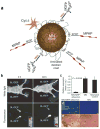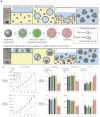Nanoparticle-based theranostic agents
- PMID: 20691229
- PMCID: PMC2988080
- DOI: 10.1016/j.addr.2010.07.009
Nanoparticle-based theranostic agents
Abstract
Theranostic nanomedicine is emerging as a promising therapeutic paradigm. It takes advantage of the high capacity of nanoplatforms to ferry cargo and loads onto them both imaging and therapeutic functions. The resulting nanosystems, capable of diagnosis, drug delivery and monitoring of therapeutic response, are expected to play a significant role in the dawning era of personalized medicine, and much research effort has been devoted toward that goal. A convenience in constructing such function-integrated agents is that many nanoplatforms are already, themselves, imaging agents. Their well-developed surface chemistry makes it easy to load them with pharmaceutics and promote them to be theranostic nanosystems. Iron oxide nanoparticles, quantum dots, carbon nanotubes, gold nanoparticles and silica nanoparticles, have been previously well investigated in the imaging setting and are candidate nanoplatforms for building up nanoparticle-based theranostics. In the current article, we will outline the progress along this line, organized by the category of the core materials. We will focus on construction strategies and will discuss the challenges and opportunities associated with this emerging technology.
Published by Elsevier B.V.
Figures







References
-
- Del Vecchio S, Zannetti A, Fonti R, Pace L, Salvatore M. Nuclear imaging in cancer theranostics. Q J Nucl Med Mol Imaging. 2007;51:152–163. - PubMed
-
- Nie S, Xing Y, Kim GJ, Simons JW. Nanotechnology applications in cancer. Annu Rev Biomed Eng. 2007;9:257–288. - PubMed
-
- Liu Y, Miyoshi H, Nakamura M. Nanomedicine for drug delivery and imaging: a promising avenue for cancer therapy and diagnosis using targeted functional nanoparticles. Int J Cancer. 2007;120:2527–2537. - PubMed
-
- Cai W, Chen X. Multimodality molecular imaging of tumor angiogenesis. J Nucl Med. 2008;49(Suppl 2):113S–128S. - PubMed
-
- Cai W, Chen X. Nanoplatforms for targeted molecular imaging in living subjects. Small. 2007;3:1840–1854. - PubMed
Publication types
MeSH terms
Substances
Grants and funding
LinkOut - more resources
Full Text Sources
Other Literature Sources
Medical

